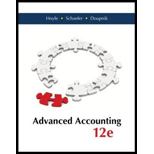
a.
Determine the amounts that Company M would report in its post-acquisition
a.
Explanation of Solution
The amounts that Company M would report in its post-acquisition balance sheet are as follows:
| Particulars | Company C | Company K | |
| Cash | $ 18,000 (1) | $ 20,000 | |
| Receivables | $ 270,000 | $ 90,000 | |
| Inventory | $ 360,000 | $ 140,000 | |
| Land | $ 200,000 | $ 180,000 | |
| Buildings (net) | $ 420,000 | $ 220,000 | |
| Equipment (net) | $ 160,000 | $ 50,000 | |
| Investment in Company T | $ 515,000 (2) | ||
| Total assets | $ 1,943,000 | $ 700,000 | |
| Accounts payable | $ (150,000) | $ (40,000) | |
| Long-term liabilities | $ (630,000) | $ (200,000) | |
| Common stock | $ (130,000) | $ (120,000) | |
| Additional paid-in capital | $ (528,000) (3) | $ - | |
| $ (505,000) (4) | $ (340,000) | ||
| Total liabilities and equity | $ (1,943,000) | $ (700,000) |
Table: (1)
Working note:
Calculation of cash:
(1)
Calculation of investment:
(2)
Calculation of Additional paid-in Capital:
(3)
Calculation of Retained earnings, 1/1/15:
(4)
b.
Prepare a worksheet to consolidate the balance sheets of these two companies as of January 1, 2015.
b.
Explanation of Solution
The worksheet to consolidate the balance sheets of these two companies as of January 1, 2015 is as follows:
| Particulars | Company C | Company K | Consolidated Entries | Consolidated Balances | ||
| Cash | $18,000 | $20,000 | $38,000 | |||
| Receivables | $270,000 | $90,000 | $360,000 | |||
| Inventory | $360,000 | $140,000 | $5,000 | $505,000 | ||
| Land | $200,000 | $180,000 | $20,000 | $400,000 | ||
| Buildings (net) | $420,000 | $220,000 | $30,000 | $670,000 | ||
| Equipment (net) | $160,000 | $50,000 | $210,000 | |||
| Investment in Company T | $515,000 | $460,000 | ||||
| $55,000 | $0 | |||||
| Total assets | $1,943,000 | $700,000 | $2,183,000 | |||
| Accounts payable | ($150,000) | ($40,000) | ($190,000) | |||
| Long-term liabilities | ($630,000) | ($200,000) | ($830,000) | |||
| Common stock | ($130,000) | ($120,000) | $120,000 | ($130,000) | ||
| Additional paid-in capital | ($528,000) | $0 | ($528,000) | |||
| Retained earnings, 1/1/15 | ($505,000) | ($340,000) | $340,000 | ($505,000) | ||
| Total liabilities and equity | ($1,943,000) | ($700,000) | $515,000 | $515,000 | ($2,183,000) | |
Table: (2)
Want to see more full solutions like this?
Chapter 2 Solutions
Advanced Accounting - Standalone book
- Goodwill is an example of an indefinite-life intangible asset, meaning that public companies must test it for impairment rather than regularly amortizing to systematically reduce its value on the balance sheet of the public company. Can anyone recap the difference between limited-life versus indefinite-life intangible assets? Any specific examples of either category?arrow_forwardWhy are adjusting journal entries necessary at the end of an accounting period? Need hearrow_forwardWhy are adjusting journal entries necessary at the end of an accounting period?i need helparrow_forward

 AccountingAccountingISBN:9781337272094Author:WARREN, Carl S., Reeve, James M., Duchac, Jonathan E.Publisher:Cengage Learning,
AccountingAccountingISBN:9781337272094Author:WARREN, Carl S., Reeve, James M., Duchac, Jonathan E.Publisher:Cengage Learning, Accounting Information SystemsAccountingISBN:9781337619202Author:Hall, James A.Publisher:Cengage Learning,
Accounting Information SystemsAccountingISBN:9781337619202Author:Hall, James A.Publisher:Cengage Learning, Horngren's Cost Accounting: A Managerial Emphasis...AccountingISBN:9780134475585Author:Srikant M. Datar, Madhav V. RajanPublisher:PEARSON
Horngren's Cost Accounting: A Managerial Emphasis...AccountingISBN:9780134475585Author:Srikant M. Datar, Madhav V. RajanPublisher:PEARSON Intermediate AccountingAccountingISBN:9781259722660Author:J. David Spiceland, Mark W. Nelson, Wayne M ThomasPublisher:McGraw-Hill Education
Intermediate AccountingAccountingISBN:9781259722660Author:J. David Spiceland, Mark W. Nelson, Wayne M ThomasPublisher:McGraw-Hill Education Financial and Managerial AccountingAccountingISBN:9781259726705Author:John J Wild, Ken W. Shaw, Barbara Chiappetta Fundamental Accounting PrinciplesPublisher:McGraw-Hill Education
Financial and Managerial AccountingAccountingISBN:9781259726705Author:John J Wild, Ken W. Shaw, Barbara Chiappetta Fundamental Accounting PrinciplesPublisher:McGraw-Hill Education





